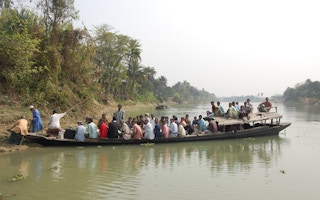Wildfires and flash floods are two of the most visible symptoms of climate change across the Himalayas.
The two phenomena are more connected than you might think. Experts believe that more intense forest fires are a major reason for the rise in flash floods in the Himalayas over the past 20 years. Here we explain this connection, why experts refer to this as a ‘vicious cycle’ – and some of the possible solutions to break it.
Forest fires across the Himalayas
Between 2001 and 2021, more than 35,000 hectares of tree cover were lost to wildfires in the Himalayas, according to Global Forest Watch data. (This figure refers to wildfires across Nepal and Bhutan, and Himalayan areas of India and Pakistan.) Analysis of this data shows that the total area of forest that was burned to some degree was 1.4 per cent greater in 2011-2020 than in the previous decade, rising from over 7,200,000 hectares to more than 7,300,000 hectares.
While comprehensive data is difficult to obtain, there are indications that forest fires have been intensifying in parts of the Himalayas in recent years. Officials in Nepal said that the November 2020-March 2021 fire season was the country’s worst since records began in 2012. Similarly, officials described the number of fires reported last year in areas of northern Pakistan as “unheard of”.
“What we’ve seen on a global scale is that hotter and drier conditions caused by climate change can make forests more prone to wildfires,” says James MacCarthy, a research analyst at Global Forest Watch. “As fire incidences expand into higher elevations in the western Himalayas, forest fires could become more widespread in that region, with some data suggesting they already are.”
Experts say the number of wildfires is influenced by a combination of climate change and forest governance.
Hemant Dhyani, convenor of the Ganga Ahwan movement, which works to protect and conserve the Ganga River and Himalayas, says the biggest factor is changing rainfall patterns. “The precipitation during winters has gone down,” says Dhyani. “The soil is becoming dry. Fires which were earlier spread over just one hectare are now spreading over 5-10 hectares as there is no moisture in the soil to limit its spread.”
“
With no vegetation present to hold the soil together [after a fire], it becomes more susceptible to erosion during extreme events like cloudbursts.
Samir Kumar Sinha, head of conservation, Wildlife Trust of India
More frequent heatwaves are also partly to blame, according to Anil Prakash Joshi, founder of the Himalayan Environmental Studies and Conservation Organisation, an Indian NGO that provides technological help to farmers in the Himalayas. Heatwaves not only increase the chance of a wildfire, by creating a hotter and drier landscape, but also cause plants to shed more of their leaves, providing more fodder for fires and increasing their intensity, says Joshi.
According to Ravi Chopra, founding director of non-profit the People’s Science Institute in Dehradun, Uttarakhand, poor forest governance has played an even bigger role.
He says that local communities are increasingly alienated from the forests, citing the erosion of the van panchayat system. Starting in 20th-century India, these village forest councils governed the forest area surrounding their respective villages and empowered the local community to control their own resources. However, a number of legislative changes over the past 100 years have weakened the system and handed decision-making power to forest department officials.
“Nowadays, whenever there is a forest fire, villagers think that it is the job of the government to bring it under control… They do not feel any ownership or sense of belonging with the forests. That old scene of villagers rushing out with buckets of water to put out the fire is missing now,” says Chopra.
Flash floods are becoming more frequent and damaging
Since 1968, 17 major flash floods have occurred in the Indian Himalayas. Of these, 13 happened after 2000, according to EM-DAT, a database of international disasters. More than 2,000 people have been killed by flash floods in the Indian Himalayas since 2000, and thousands more have been injured.
Pakistan’s northern province of Khyber Pakhtunkhwa is frequently hit by flash floods. In 2022, as the country experienced its worst floods in a decade, flash flooding killed 185 people in Khyber Pakhtunkhwa. The previous year 20 people died in flash floods in the province, and in 2020 46.










